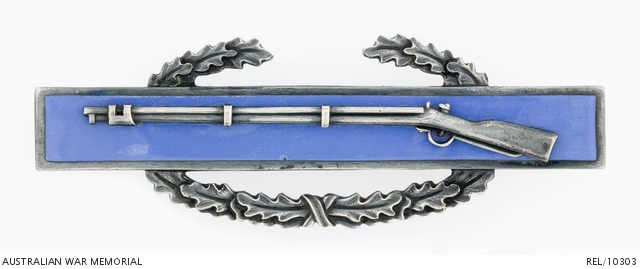| Place | Europe: France |
|---|---|
| Accession Number | REL/10303 |
| Collection type | Heraldry |
| Object type | Badge |
| Physical description | Enamel, Silver |
| Maker |
N S Meyer, Inc |
| Place made | United States of America |
| Date made | Unknown |
| Conflict |
Second World War, 1939-1945 |
United States Combat Infantryman Badge : Lieutenant E J Kehoe Jr, 117th Infantry Regiment, 30th Division, US Army

United States Combat Infantryman Badge featuring a silver musket on a thin horizontal blue enamelled rectangular background with a silver border. The rectangle is set over an open-ended oak wreath. The reverse is stamped with 'STIRLING', the maker's name and mark and engraved with, 'LT. EDWARD J. KEHOE 117TH INFANTRY 1944'. There are two pins attached with butterfly clasps in place.
The United States Combat Infantryman Badge is awarded to enlisted men and officers (commissioned and warrant) below the rank of colonel, who personally fought in active ground combat while an assigned member of either an infantry or a Special Forces unit, of brigade size or smaller, any time after 6 December 1941.
This example was awarded to Lieutenant Edward J Kehoe Jr, 117th Infantry Regiment, 30th Division US Army. Edward J 'Ted' Kehoe was born in Philadelphia, Pennsylvania, USA and attended high school at Valley Forge Military Academy, which included officer training usually found in universities. Consequently, Kehoe was sworn in as a Second Lieutenant on his 18th birthday on 31 August 1942, making him one of the youngest officers in the US Army at the time.
Kehoe was assigned to command a platoon of 81 mm mortars in a National Guard (state militia) unit - H Company, 2nd Battalion, 117th Regiment, 30th Infantry Division. The 30th Division travelled to England in February 1944 and landed in France on 11 June - five days after D-Day. Kehoe was awarded the Combat Infantryman Badge on 15 June 1944 for his 'exemplary conduct in action against the enemy'. Lieutenant Kehoe participated in a series of battles around St Lo, starting with a river crossing on 7 July, through to the 'breakout' (Operation Cobra) on 28 July.
During these operations Kehoe was shot and wounded in a 'friendly fire' accident. He was evacuated to Britain and eventually to America where he fully recovered from his wounds. In 1946 Kehoe married the chaplain's daughter whom he had met during VJ (Victory over Japan) Day celebrations. He later obtained a university degree in business and had a successful career as a middle manager in the insurance industry. He has a son, who is an officer in the Australian Army, and two daughters, who both live in the US.